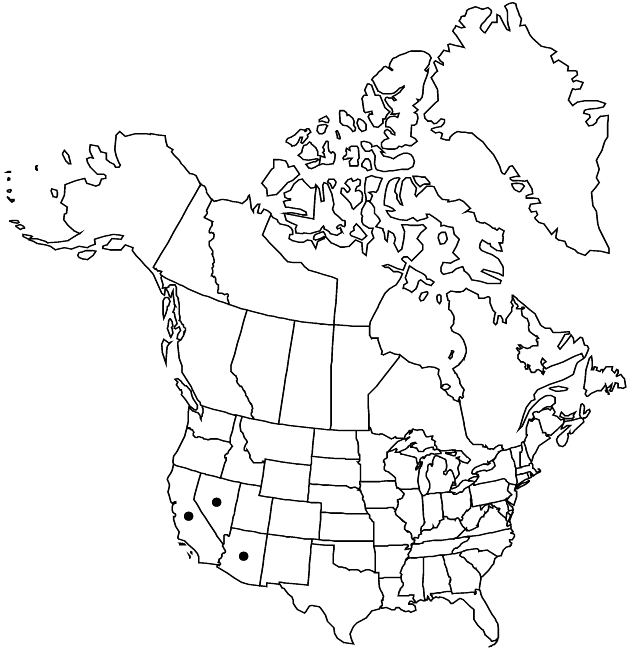Difference between revisions of "Senecio mohavensis"
in A. Gray et al., Syn. Fl. N. Amer. 1(2): 446. 1884.
FNA>Volume Importer |
FNA>Volume Importer |
||
| Line 25: | Line 25: | ||
|discussion=<p><i>Senecio mohavensis</i> is similar to S. flavus (Decaisne) Schultz-Bipontinus of the Mediterranean region and southwest Asia, which raises phytogeographic questions (cf. A. Liston et al. 1989; Liston and J. W. Kadereit 1995; M. Coleman et al. 2001). The last cited study showed that a previously recognized variety of S. flavus is more closely related to <i>S. mohavensis</i> than to S. flavus and a new combination was made: <i>S. mohavensis</i> <i></i>subsp.<i> brevifolius</i> (Kadereit) M. Coleman.</p> | |discussion=<p><i>Senecio mohavensis</i> is similar to S. flavus (Decaisne) Schultz-Bipontinus of the Mediterranean region and southwest Asia, which raises phytogeographic questions (cf. A. Liston et al. 1989; Liston and J. W. Kadereit 1995; M. Coleman et al. 2001). The last cited study showed that a previously recognized variety of S. flavus is more closely related to <i>S. mohavensis</i> than to S. flavus and a new combination was made: <i>S. mohavensis</i> <i></i>subsp.<i> brevifolius</i> (Kadereit) M. Coleman.</p> | ||
|tables= | |tables= | ||
| − | |references= | + | |references={{Treatment/Reference |
| + | |id=coleman2001a | ||
| + | |text=Coleman, M., D. G. Forbes, and R. J. Abbott. 2001. A new subspecies of Senecio mohavensis (Compositae) reveals Old-New-World species disjunction. Edinburgh J. Bot. 58: 389–403. | ||
| + | }}{{Treatment/Reference | ||
| + | |id=liston1989a | ||
| + | |text=Liston, A., L. H. Rieseberg, and T. S. Elias. 1989. Genetic similarity is high between intercontinental disjunct species of Senecio (Asteraceae). Amer. J. Bot. 76: 383–388. | ||
| + | }}{{Treatment/Reference | ||
| + | |id=liston1995a | ||
| + | |text=Liston, A. and J. W. Kadereit. 1995. Chloroplast DNA evidence for introgression and long distance dispersal in the desert annual Senecio flavus (Asteraceae). Pl. Syst. Evol. 197: 33–41. | ||
| + | }} | ||
}}<!-- | }}<!-- | ||
| Line 42: | Line 51: | ||
|elevation=100–700 m | |elevation=100–700 m | ||
|distribution=Ariz.;Calif.;Nev.;Mexico (Sonora). | |distribution=Ariz.;Calif.;Nev.;Mexico (Sonora). | ||
| − | |reference= | + | |reference=coleman2001a;liston1989a;liston1995a |
|publication title=in A. Gray et al., Syn. Fl. N. Amer. | |publication title=in A. Gray et al., Syn. Fl. N. Amer. | ||
|publication year=1884 | |publication year=1884 | ||
|special status= | |special status= | ||
| − | |source xml=https://jpend@bitbucket.org/aafc-mbb/fna-data-curation.git/src/ | + | |source xml=https://jpend@bitbucket.org/aafc-mbb/fna-data-curation.git/src/f50eec43f223ca0e34566be0b046453a0960e173/coarse_grained_fna_xml/V19-20-21/V20_1254.xml |
|tribe=Asteraceae tribe Senecioneae | |tribe=Asteraceae tribe Senecioneae | ||
|genus=Senecio | |genus=Senecio | ||
Revision as of 20:24, 16 December 2019
Annuals, 10–30(–40) cm (taproots often twisted). Herbage (sometimes purple-tinged) glabrous. Stems usually 1 (freely branching upward). Leaves equally distributed; petiolate; blades ovate to obovate, 2–6 × 0.5–2(–4) cm, bases tapered, margins coarsely lobed or irregularly dentate (mid and distal leaves similar, bases expanded, truncate to cordate, clasping, 1–2 cm across). Heads 3–10 in loose, cymiform arrays. Calyculi of 3–5+ lance-linear bractlets. Phyllaries ± 8 or ± 13, 6–7 mm, tips green. Ray florets 0 or 1–3+; corolla laminae 0.1–1 mm (little expanded, barely, if at all, surpassing phyllaries; sometimes laminae 0 and heads perhaps technically disciform). Cypselae hairy. 2n = 40.
Phenology: Flowering spring.
Habitat: Sandy or rocky washes, desert flats
Elevation: 100–700 m
Distribution

Ariz., Calif., Nev., Mexico (Sonora).
Discussion
Senecio mohavensis is similar to S. flavus (Decaisne) Schultz-Bipontinus of the Mediterranean region and southwest Asia, which raises phytogeographic questions (cf. A. Liston et al. 1989; Liston and J. W. Kadereit 1995; M. Coleman et al. 2001). The last cited study showed that a previously recognized variety of S. flavus is more closely related to S. mohavensis than to S. flavus and a new combination was made: S. mohavensis subsp. brevifolius (Kadereit) M. Coleman.